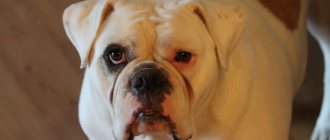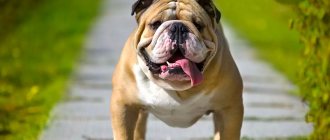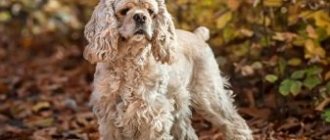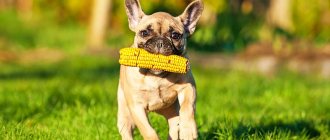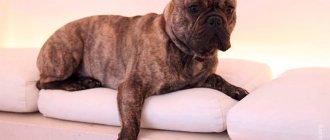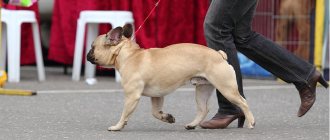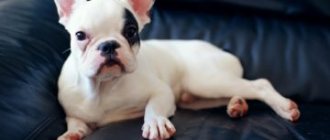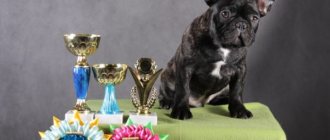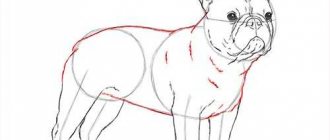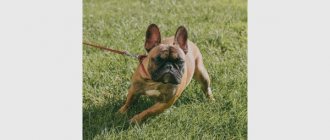England has become the birthplace of many famous dog breeds that have gained popularity among dog breeders around the world. Another representative of Foggy Albion, the English bulldog, was no exception. This is a true gentleman among dogs, distinguished by restraint and equanimity. Thanks to its amazing appearance, loyalty to its owners and ease of care, the breed is loved by many breeders outside its homeland.
Description
Bulldog smiles
English bulldogs, along with Dalmatians and retrievers, are considered one of the most easily recognizable breeds. A distinct characteristic of this breed is its short legs and large muzzle.
— Advertising —
English bulldogs have a distinctive look. Their heads are large and round, and their muzzles are flat. Individuals have a third eyelid. Dogs have large, wide-set jaws, which makes their bite force significant. Dogs have an overbite, causing their lower teeth to stick out above their upper teeth. The animals have a short and thick body, with broad shoulders and stocky legs. The pets' tail sticks up.
They come in a variety of colors, although the most common are white and brown. Characteristics of the English Bulldog species are presented below.
- Blue or blue English bulldog. This is a variation of the traditional dog, which differs in the color of its coat. Blue English Bulldogs have a mixture of gray and white coloring.
- British Bulldog. These are the standard English Bulldogs that you see most of the time on the street and in pictures. They are brown and white in color, with dark brown eyes.
- Mini bulldog, or "dwarf". This is a variety of the breed that is much smaller in size and has less wrinkled cheeks and a plump build.
English Bulldog Standard
English bulldogs are medium in size. The breed belongs to the mastiff group, a group of Molossians. The physique is compact, powerful muscles. According to the standard, height at the withers does not exceed 40 cm, and weight does not exceed 25 kg. And female English bulldogs are generally small: they weigh up to 20 kg and are 36 cm tall.
These dogs have an unusual, memorable appearance. When describing its features, one can note a large, wide head, an upturned short nose, and an abundance of folds in the skin. English bulldogs are short-haired dogs and belong to the brachycephalic breed. Due to the unusual structure of the muzzle and drooping cheeks, they look menacing and even intimidating. But some people consider this dog’s appearance to be cute. And when she opens her mouth, it seems that she is smiling.
Head Features
The head is quite large, wide, and square in format. The forehead is flat, wide, with a distinct furrow running along it from the stop. The muzzle is short, wide and flat. There are pronounced folds on the forehead, bridge of the nose and cheeks. The nose is upturned, the lobe is wide, always black, surrounded by folds.
The English Bulldog's eyes are set low, in line with the stop. Set wide apart, neither convex nor sunken. Eye color is dark, blue is not allowed, round shape.
The jaw is massive and square. The teeth are large, even, and do not protrude, but this breed is characterized by an undershot. When viewed from the side, it seems that the lower jaw protrudes forward, and the upper one seems to sink. The lips are thick, fleshy, black. The jowls hang down strongly, completely covering the sides of the jaws.
The English Bulldog's ears are set high. Located far from the eyes. The ears are small, thin, and rose-shaped. This is how triangular ears are characterized, the tips of which are lowered, slightly turned to the sides and back.
Body type
The neck is of medium length, thick and powerful, slightly convex. The nape line is clearly defined. The skin hangs down in front, and there are large folds at the withers. The topline from the withers drops slightly, then rises again, forming an arch. The chest is deep, rounded at the sides, the stomach is tucked.
The back is short, the loin is rounded, narrow. The English Bulldog's tail is set low. Thick at the base, narrows towards the end and bends downwards. The tail is short in length, no more than 8 cm, does not rise above the back, and is pressed to the body.
Limbs
The limbs are thick and muscular. The front ones are widely spaced and shorter. Due to the rounded chest, their outer line appears curved. But they are straight and parallel. The shoulders are powerful, wide, the elbows are low.
The hind limbs are longer than the forelimbs. They are also thick and powerful. The hock joints are set low, the knees are rounded, slightly turned outward. The paws are compact, the toes are large and straight.
A characteristic feature of the English Bulldog breed is its gait. They move on their fingertips in short, quick steps. The shoulders move forward when walking. The hind limbs do not rise high, but “shuffle” along the ground.
The images complement the description of the appearance of these dogs:
White English Bulldog
English bulldog at the dacha
Appearance of an English Bulldog
Coat and color
The English Bulldog is a short-haired dog. The coat is smooth, delicate, lies tightly, has a velvety structure, not wavy. There is no undercoat, the length of the guard hair is no more than 1.5 cm. The skin is thick and lies loosely. Forms many folds throughout the body.
Several colors of English bulldogs are allowed:
- all shades of red:
- red brindle and other brindle colors;
- red and white;
- brown-yellow;
- pure white;
- deer;
- piebald;
- smut - any solid color with a mask on the face, like a muzzle.
Preference is given to the traditional brindle color. Colors should be bright and saturated. If there are stains, they should be evenly distributed. Black color is not recognized as a standard; it is allowed only in the form of spots. Disqualifying defects also include blue and brown. With a solid color, the chest and belly of the English Bulldog are usually white.
English bulldog photo:
White head of an English bulldog
English bulldog muzzle
Color red and white
Varieties
In addition to the English Bulldog, there are two more varieties that are registered as separate breeds. They are similar in appearance, but there are slight differences. The American Bulldog was bred to help on the farm, protect property, and hunt. It is larger in size, harmoniously built, weighs 50-58 kg. Folds are only on the neck and muzzle, the tail is long. Ambuli are agile, hardy, but also stubborn and good-natured.
The smallest representatives of the breed were used in France to create another breed - the French bulldog. Their peculiarity is their small stature; they weigh no more than 15 kg. They have a smaller head, a less muscular build, fewer folds, and erect ears that are wide at the base. This is a decorative breed, classified as a toy. By nature, French bulldogs are more sociable, active and cheerful.
Appearance
The photo shows an adult English bulldog.
These are medium-sized dogs, but in general, their parameters are far from small. The weight of dogs depends on their age.
| Age | Weight standards, kg |
| 1 month | 2,3 |
| 3-5 months | 6,8-13,6 |
| Grown up boy | 23,6-24,9 |
| Grown up girl | 21,8-22,7 |
— Advertising —
You will have to feed puppies more often than adults. They need good nutrition due to their growth and the need to develop bone mass. Bulldogs are considered adults when they reach 18 months.
The animals are not tall, compared to other dogs. Girls and boys grow up to 31–40 centimeters in height. That's why they look short and bulky.
The dog can be of different colors and color combinations, the most common shades are:
- White
- Ginger
- Pale yellow
- brindle
- Red
- Yellow.
A dog can be “smoot” in color when its body is monochromatic and its muzzle is black. The body may contain combinations of two or three of the above colors, as well as many spots.
Feeding
When choosing a natural diet, focus on easily digestible foods - cereals, vegetables, dairy products. Meat and offal make up up to 40% of the diet. Add additional vitamin supplements.
Use premium dry food from a special line. Make sure clean water is always available and change daily.
The number of feedings depends on age:
| Age (months) | Number of feedings |
| Up to 2 | 6 |
| 2–3 | 5 |
| 4–6 | 4 |
| 6–8 | 3 |
| 8+ | 2 |
What can you feed
- Cereals: rice, buckwheat, oatmeal.
- Lean meat: beef, turkey, chicken.
- By-products: heart, liver, lungs, stomachs.
- Fermented milk products: kefir, cottage cheese, fermented baked milk.
- Boiled and raw vegetables.
- Fruits: apples, plums, pears.
- Chicken and quail eggs.
- Seafood.
What not to feed
- Smoked products: sausages, cheeses.
- Lamb, pork.
- River fish.
- Bakery products.
- Milk.
- Potato.
- Legumes.
- Sweet, salty, peppery and spicy.
Pros and cons of a dog
Bulldog looking at the camera
pros
English Bulldogs are lovely pets for a relaxed family looking for another member. Apart from health concerns, they do not require much care or exercise.
Cute bulldog puppy
The animals are very loyal, making them worthy guard dogs for your home. Dogs love to socialize and relax with their owners and their children. Also, the dog does not bark or yap, so it will not interfere with rest or sleep.
Minuses
However, the breed is not for everyone. One reason: lifelong health problems. You must be prepared for this, and also be always on the alert and visit your local veterinarian on time.
A sleeping bulldog constantly snores loudly and makes noises. This may cause discomfort. Some individuals drool heavily.
Dogs are one of the most popular breeds in the world, which makes them expensive pets. You must be willing and able to invest in them throughout their lives as they get sick often. Therefore, consider your financial capabilities before choosing such a pet.
Price
Despite its popularity, the cost of this dog breed, regardless of the place of purchase, will be quite high. There are several ways to buy a dog, the first is to purchase it through an advertisement or at a poultry market. With this option, there are no guarantees of the purity of the breed and there is a high probability that the new owner will cheat, but the price of an English bulldog will be significantly lower than in the kennel.
If you need a dog to participate in exhibitions, for further breeding, or just a dog without flaws, then you need to contact a kennel where English bulldogs are kept. With this option, the new owner will be presented with all the necessary guarantees, namely information about vaccinations, pedigree, and information about the bulldog’s parents.
However, the cost will be high, and vary from 35 to 70 thousand rubles, although you can find higher ones. According to an advertisement or at the poultry market, you can buy an English bulldog for 20-30 thousand rubles.
Thus, the main advantages of the English Bulldog are devotion to the owner, calm and serious character, he is not demanding for long walks, gets along well with the whole family and pets, the main disadvantages of this breed are high pain and whimsicalness in care and maintenance.
History of the breed
Various English Bulldogs
The first mention of the breed appears in reports that date back to the times of the ancient Romans (31 BC to 476 BC). These works mention powerful, wide-mouthed dogs who fought alongside soldiers (Romans, Greeks and English) with great courage and valor.
The earliest written use of the name "bulldog" actually dates back to 1631 and is based on correspondence about the shipment of dogs from Spain to London.
As the name suggests, the English Bulldog breed was originally bred in England for the sport known as bullbaiting. In this medieval sport, dogs attacked and teased tethered bulls. However, bullbaiting was outlawed in 1865. It would seem that this should have been the end for the animals, but smart breeders turned the “war machine” into a friendly pet. Today, the bulldog is considered a breed that is not prone to aggression.
Socialization
Socialization of the puppy begins as early as possible. The dog must learn the rules of living in the house and get used to the environment. Later, the baby is introduced to relatives, new people and smells. It is advisable that the pet undergo a general training course (GDC).
The dog is also accustomed to other pets during puppyhood. Conflicts are possible between adults, since the English Bulldog breed is prone to dominance. However, most often the pets calmly divide the territory.
Englishmen and children get along well if the latter treat dogs with respect. The pet will not turn into a soft toy, but will become a faithful playmate. In response to excessive activity of a child, the animal will turn around and walk away rather than bite.
Maintenance and care
Two English bulldogs together in the garden
- You need to wipe the wrinkles on your pet's face every day. Use baby wipes or mild soap and a washcloth. Why does this need to be done so often? With poor care, bacteria and sweat accumulate inside the folds, causing irritation. If your pet's wrinkled skin becomes irritated, gently rub a small amount of Vaseline around the wrinkles.
- Even though it is a short-haired breed and does not shed, you will need to brush your dog several times a week. Use a soft brush or rubber comb to remove dead hair. In spring and autumn, the bulldog sheds old hairs a little more, so you will have to groom him daily or every other day. While cleaning, inspect your dog's skin for rashes, flaking, and excessive dandruff. The sooner you detect similar problems, the easier and faster it will be to cure them.
- Well-groomed animals do not need frequent bathing unless they get into something dirty. Frequent bathing can cause dry and itchy skin as it removes natural oils from the body. However, if your bulldog develops skin conditions, you will need to bathe him with special medications prescribed by your veterinarian.
- The ideal environment for a dog is a home with plenty of space. They should stay indoors most of the time and only go outside for exercise and play. Dogs do not feel well at both very high and low temperatures. The normal body temperature of a dog is 38.6℃. A higher temperature may indicate the pet is overheating.
- To walk dogs, owners purchase a harness, not a leash.
How to buy an English bulldog puppy
It is recommended to buy a puppy from a good breeder or kennel. This guarantees the purity of the breed and the absence of congenital pathologies. A purebred puppy will cost 20-35 thousand rubles, and offspring from exhibition winners will cost from 40 thousand. You can buy a puppy without documents for 5,000 rubles, but it may turn out to be a mixed breed or sick.
Buy a dog at the age of 1.5-3 months. When choosing, you need to pay attention to the documents: there must be a pedigree, a veterinary passport. It is also important to examine the dog's appearance. The coat should be smooth, shiny, eyes and ears clean, without discharge. The paws are thick, widely spaced and even, the belly is not bloated. The puppy should be active, cheerful, and not cowardly. Bitches are more flexible and easier to train. And males are more courageous and active.
Photos show what the puppies look like:
To decide whether to get an English bulldog, you can watch the video:
Video: English Bulldog! Full description of the dog breed!
Video: All about the English Bulldog breed. What is worth knowing?!
English bulldogs are affectionate, calm dogs. Despite their peaceful nature, they become good guards, scaring off intruders with their menacing appearance. This is a devoted friend, companion, nanny for a child. Now the breed has become decorative, so it has poor health. But with proper care, these dogs live for at least 10 years and give their owners a lot of love and joy. If you do not pay attention to minor shortcomings, this is an ideal pet for a city apartment.
Nutrition
English Bulldog eats
The breed has no special dietary requirements. The only recommendation is to give your dogs high quality food. When it comes to diet, keep in mind that animals tend to be overweight. This is because they do not exercise as much as other dogs. Never overfeed your pet.
Once your pet reaches 14 to 18 months of age, you can transition him to adult food. Feed your dog twice a day. A super active dog will need about 1500 calories per day, a less active dog will need 1300 calories per day
Older bulldogs (from about 6 years of age) become less active, so it is important to feed them food that contains fewer calories. 1000 calories per day is the average for your pet. Don't forget to give them extra vitamins and minerals.
General characteristics of English bulldogs
English Bulldogs are instantly recognizable dogs. They have a remarkable appearance. A stocky build, a wide flattened muzzle and an abundance of folds in the skin are their features. At first glance, it may seem that this dog is lazy and slow. But the bulldog has a loyal heart and a courageous character. If the owner or members of his family are in danger, he will bravely rush to defense.
Breeders and breed lovers consider English bulldogs to be the most good-natured and peaceful animals. They note that they are patient, kind, loyal and smart. This is an ideal pet for families with children, for the elderly, lonely or lazy. The dog senses the owner’s mood and is able to cheer him up when he’s sad. And for a child, English bulldogs can become a nanny, protector and playmate.
The English Bulldog is an obedient and devoted pet. He is independent, balanced, self-confident, and can make his own decisions. These dogs are characterized by such qualities of a gentleman as aristocracy, equanimity, and solidity. Due to its personality traits, this dog is often used as a mascot for sports teams in the UK and USA, and is now an unofficial symbol of the Marines.
| Options | Characteristic |
| breed name | English bulldog |
| country of origin | Great Britain |
| year of breed registration | 1865 |
| group of breeds according to the ICF classification | Molossians, Pinschers and Schnauzers |
| height | 31-40 cm |
| weight | male 23-25 kg, female 18-23 kg |
| life expectancy | 8-10 years |
| character traits | equanimity, poise, courage, stubbornness |
| attitude towards a person | friendly, almost non-aggressive, does not tolerate loneliness well, gets along well with children |
| care | simple, but shedding is strong |
| need for physical activity | low, walking up to an hour a day |
| training | smart, good at responding |
| health | weak |
| purpose | companion, bodyguard, watchman, nanny |
Pros of the breed
The English Bulldog is a pet that is suitable for inexperienced owners. This is a dog for a city apartment, for calm, inactive owners. She has many advantages:
- due to its compactness, the English Bulldog is easy to keep even in a small apartment;
- This is an unpretentious pet, does not require complex care or special nutrition;
- with proper upbringing, a purebred dog will never show aggression even towards strangers or bite a person;
- the dog is calm, balanced, not vindictive, rarely loses his temper and almost never barks;
- becomes attached to children, is patient with them, can become a nanny and protector;
- At home, English bulldogs do not damage furniture, do not misbehave, and calmly wait for their owner;
- does not require long walks or heavy physical activity;
- easily get along with any pets;
- This is a good watchman and protector, despite its small size, it boldly rushes to protect its owner.
Cons of the breed
It is better not to get this dog for an active person, or for someone who is rarely at home. The English Bulldog sheds, drools and emits a specific odor, so it is also not suitable for squeamish people or those suffering from allergies. Representatives of this breed have several other disadvantages:
- due to the special structure of the nose, dogs of this breed make different sounds: gurgle, snore, sniffle, breathe noisily;
- for the same reason, they cannot endure physical activity for a long time and begin to choke;
- these dogs often suffer from increased gas formation, they have a weak stomach and increased drooling;
- they are lazy, slow, and therefore prone to obesity;
- very stubborn, do not always follow the owner’s commands;
- they constantly need to gnaw and chew something, so you need to buy a lot of toys;
- do not tolerate hot and cold weather well; in summer they need to be protected from overheating, and in winter they need to wear clothes;
- Due to the peculiarities of their anatomy, bitches cannot give birth on their own; almost all puppies are born by caesarean section.
An interesting video will tell you about the pros and cons of these dogs:
Video: English Bulldog. Pros and cons of the breed
Video: English Bulldog - an obedient, phlegmatic dog
Breeding
Bulldogs on a
bench Females are in heat, as a rule, twice a year. At this time, the dogs should be brought together and mated. On average, during pregnancy, a female bears 4 puppies, and birth occurs by caesarean section. After birth, the babies are picked up and fed by their owners. This is because the parent needs some time to recover from the surgery. Postpartum visits to the veterinarian are mandatory to ensure the health of mother and puppies.
Reproduction
The first heat begins in female bulldogs at the age of 7–10 months. Before mating, it is recommended that the bitch undergo a genetic analysis, which will show her predisposition to hereditary diseases that can be passed on to offspring. Males must be tested for brucellosis.
Important! Until the dog goes through her second heat, it is not recommended to have one. The reproductive system of bulldogs is very weak, and pregnancy creates a very large load on the dog’s body, and sometimes this is dangerous for its health.
Mating bulldogs is a very difficult and troublesome task. Due to their stocky build and short legs, dogs may have trouble conceiving successfully naturally. Then the artificial insemination method is used - introducing sperm into the bitch’s vagina through a syringe.
Pregnancy lasts from 65 to 67 days, during which the dog needs to be provided with complete rest and proper care. In most cases, bulldogs are delivered via cesarean section.
The number of pups in the litter is from 3 to 8
Puppies
Two English Bulldog puppies at home
- You should feed your baby three times a day on a schedule for the first four months. After 6 months you can start cutting back to 2 times a day.
- Regular food from the store is quite suitable for your pet. Which one is better to choose? Study the first five ingredients on the label: meats should come first, then vegetables, then grains.
- Do not feed animals human products that are toxic and harmful to their bodies. For example, chocolate, raisins, avocado, green onions, garlic and so on.
- Monitor your newborn's weight. Individuals easily gain kilograms. If your puppy is gaining weight rapidly, consult your veterinarian.
- Provide 24/7 access to clean, fresh water. This is especially important in hot or humid weather.
- Give your puppy preventative treatment for local diseases.
- Take your pet for regular veterinary checkups.
- Check your pet's ears once a week. The inside of the ear is usually white or dark in color, matching the color of the dog's coat.
- Clean and inspect your baby's feet and toes regularly to prevent interdigital furunculosis or ingrown toenails.
- Socialization is very important to ensure your puppy gets along with other dogs, animals and people. Individuals aged 14 to 16 weeks are most susceptible to socialization.
- These puppies are temperature sensitive. They often suffer from heatstroke, but also do not like the cold.
How and what to feed?
The dog's diet should, first of all, be balanced. The basis of the diet is protein (it is necessary for muscles that experience enormous stress), but you should give preference to low-calorie foods. Meat should be boiled; its share in the menu is about 30-40%. Cereals, cottage cheese, and vegetables are also included in the diet. Natural food can be replaced with specialized food.
Important: do not give your pet food from your table, especially flour, smoked meats, sweets, fried foods, processed foods, fast food, and fatty foods.
Lifespan
English Bulldog on a leash
A study conducted by the British Kennel Club and the British Small Animal Veterinary Association found that the average lifespan of the species was 8 years. At the same time, about 9% of animals died from “old age.”
Another 2010 study puts the average life expectancy at 6 years. English Bulldogs were once considered healthy dogs with an average lifespan of 10 years. But today these numbers have decreased and amount to 6-8 years.
The most common causes of death are heart disease (11.8%), cancer (10.9%) and brain disorders (9.1%), and cutaneous folding dermatitis (7.8%).
Training and education
English bulldogs are very attached to people, but even this does not prevent them from being stubborn at times. Therefore, the owner should firmly and systematically achieve the execution of the given commands. Training should begin in the first weeks of life; this is the only way to raise an easy-going dog. Initially, you need to learn the following commands: come to me, next to me, you can’t (ugh), sit, place, lie down. The words must be spoken in a confident voice and the command must be given clearly so that the bulldog feels the need to obey. At the same time, it is important that the animal clearly understands from early childhood what it is forbidden to do, since the willfulness of an adult dog is more difficult to limit.
Dog character
English bulldog puppies play on the grass.
The bulldog's temperament is calm, brave and friendly. These are confident dogs that are loyal, affectionate, and sometimes funny. Although they were bred as fighting dogs in the past, modern specimens are generally not aggressive towards people. They are friendly and loving in nature. A domestic Bulldog will be a playful, active puppy in the home. The animal sleeps next to its owner, which makes it an excellent companion.
Patient, but...
They are usually not aggressive towards strangers. They get along easily with other pets. There is an alarming feature - a dog can tolerate it for a very long time, but if you anger it, it will be very difficult to stop.
Note!
Nicknames for dogs for boys - easy, rare and most beautiful names for dogs in alphabetical order
Nicknames for girls' dogs - a list of beautiful, funny, unusual nicknames for large and small dog breeds
Maltipoo dog - everything about the dog from A to Z. Photos, description of the breed, character, maintenance features, prices, reviews
Education
English bulldog with a ball
Many owners are interested in how to properly train bulldogs and when to start training. Puppies will follow the leader of the pack, and you must be that leader. As a leader, you must raise your child, teach him how to behave and fit into a new environment. Train your puppy to follow your commands. It is important to start parenting at an early age. Training will be most successful when you praise and reward your baby. Instead of punishing your puppy when he doesn't do the right thing, you should reward him when he does the right thing.
If you are unable to train your pet yourself, contact your local dog behaviorist.
Features of the first days of life
It is clear that giving birth to a purebred bitch should be entrusted to a qualified veterinarian. At the same time, you may have to take on the duties of a midwife while the doctor is on the road.
And when he gets to the woman in labor, he will almost certainly need an assistant. Be prepared when the puppy is removed or naturally emerges from the birth canal:
- Tear and remove the shell, starting from the head (nose) of the puppy.
- Remove mucus from the puppy's mouth and nose using a sanitary napkin.
It is possible that amniotic fluid will flow from the nasopharynx. This is normal and you can also take it on a tissue or tampon.
The specific “bulldog” structure of the nasopharynx sometimes makes these simple operations difficult, so be prepared to suck out the liquid with a special pipette.
A syringe is usually not suitable due to its too large size. If you are confident that you can hold a slippery newborn in your hands, you can shake out all the liquid in an up and down motion.
Scissors and thread should be disinfected ahead of time, for example, by soaking them in boiling water for 5-15 minutes.
Act energetically and remember the fragility of the newborn. This active massage promotes rapid drying and affects a number of functions:
- improves blood circulation;
- activates breathing;
- stimulates intestinal motility;
- promote the passage of meconium.
Diseases
Bulldog sad
- Dry eyes. Individuals often experience lacrimation. This can cause a "blue haze" to appear on the eyes, which damages vision and causes pain. To combat this problem, contact your veterinarian, who will prescribe the necessary medication.
- Sneezing. Sneezing, in most cases, is normal in both dogs and humans. Reverse sneezing, also known as an inverted sneeze, occurs when nasal fluids drip into your pet's soft palate. At this point, pets may cough and choke. This is usually not serious, so the best way for your dog to escape from you is to comfort the animal during an attack.
- Brachycephalic syndrome. With the syndrome, your pet's airways are closed. This may be due to problems in the nose or roof of the mouth. The dog is breathing with difficulty, coughing and sniffing a lot. Contact a specialist immediately.
- Shakes his head. Your animal will begin to shake its head up and down or from side to side for no apparent reason, and a slight tremors will appear. This is caused by stress as well as low blood sugar. Give your pet a spoonful of honey. If this doesn't help, contact your veterinarian.
- Hip dysplasia. Hip dysplasia is an inherited disease. In this problem, the femur does not fit tightly into the hip joint, causing it to move abnormally. Most English Bulldogs have hip dysplasia based on their natural build. Therefore, consult a specialist for a diagnosis.
- Allergy. Animals may be allergic to certain foods, chemicals and other irritants. The dog develops rashes and hair falls out. Contact a specialist who can help identify the cause.
Historical reference
Country of origin: UK. The ancestors are the dogs Crib and Rose, entered into the stud book in 1817. The ancestors are the Old English Bulldogs - an extinct breed of baiting dogs that was used in “blood sports” (bull baiting, dog fighting). There is another opinion: bulldogs descended from Alans - mastiff-shaped dogs living in the Caucasus Mountains.
The breed was first presented at an exhibition in 1860 (Birmingham, England). The first standard was adopted in 1875. Bulldogs could not be exported from the country until the 80s of the 20th century. Currently, several standards have been developed; the FCI standard, approved in 2004, is in force in the Russian Federation.
Representatives of the breed came to Russia even before the revolution, but did not become popular. In 1923, breeding was suspended due to “emphasized bourgeoisism that does not correspond to the socialist way of life.” Selection was resumed in the 80s. 20th century, however, many individuals were deficient due to the lack of an influx of new blood. In the mid-90s. Bulldogs with excellent breed characteristics were imported from the world's leading nurseries. Currently, many dogs from Russia take prizes at major international dog shows.
Interesting Facts
Bulldog tore a tennis ball
- Many US presidents have owned pets during their time in the White House, but only one of them had an English bulldog. This was the 29th President of America, Warren Harding.
- More than 80 percent of bulldogs are born by cesarean section. This is due to the size of the head, which prevents the natural birth of babies.
- Many celebrities have this look, including Leonardo DiCaprio, Reese Witherspoon, David Beckham, Ashley Olsen, Hugh Jackman, Zac Efron and Martha Stewart.
- Animals suffer greatly during flights due to problems with breathing and heat regulation. Because of this, many airlines prohibit flying with these dogs.
- A special feature of the breed is that old English bulldogs can jump up to 200 centimeters in the air.
- The species is one of the most common school mascots in America. Nearly 40 universities across the country name their sports teams after the Bulldogs.
- In England, animals are considered a national breed. World War II propaganda portrayed the country as a tough-looking bulldog. Germany was then represented by the dachshund, and the United States was represented by the American pit bull. Winston Churchill was called the “British Bulldog” due to his behavior, and perhaps his appearance.
- Otto the Skateboarding Dog broke the Guinness World Record in 2015 for the Longest Tunnel Compassed by a Dog on a Skateboard. Photos of the dog are presented below.
- One owner from Cleveland, Ohio, USA, reported that his dog Oliver had a lifespan of 20 years.
- The Staffordshire Bull Terrier is a cross between an English Bulldog and a Terrier.
Baby care
English bulldogs, like newborn French bulldog puppies or other similar dogs, cannot maintain their body temperature on their own. In most breeds, heat loss is compensated by the mother, who warms the brood with her body.
Thanks to this, the puppy’s temperature range is normal - 35.5-37.8 ° C. In the English Bulldog, maternal care is rare, and the mother rarely gathers the puppies closer to her body, so newborns who cannot crawl will freeze.
Temperature conditions
To ensure thermal comfort, the box with puppies should be placed away from possible drafts and heating devices. This will avoid hypothermia or overheating and facilitate thermoregulation.
The temperature in the room with the brood should be within +24. +26 °C, and in the first week after birth, provide warming up to +29 °C. Air humidity should be between 50-70%. As bulldogs grow, the temperature should be lowered 2-3 degrees per week. After three weeks, a room temperature of +20 °C will be enough.
Cleanliness and hygiene
Ventilation of a room with a litter of bulldogs must be carried out daily (once) and is mandatory. The bed should be cleaned every day or when dirty.
It is recommended to bathe the puppy completely monthly or when it gets dirty (for example, after an active run through the mud). Use a special shampoo after consulting a dog trainer or veterinarian.
Washing paws is necessary after every walk in the fresh air and is usually carried out without the use of foam detergents. You can wash the face and folds on it every day and also without soap or other similar products.
If the puppy has not yet become accustomed to water procedures, then try not to frighten him, so do not raise your voice throughout the entire bathing or washing process.
Fill the bath with a little water - just above the little bather's knees. Comfortable temperature is the same as for children, and is determined simply - immerse your elbow in the bath to a depth of 6-9 cm.
If you don’t trust your feelings, then the thermometer should show + 36. +38 °C. Use a special shampoo and, if desired, a soft brush or fluffy washcloth.
Take care of children's pedicure in a timely manner so that the claws do not injure the bitch, and claw trimming should begin from the 4th-6th day of life.
We take care of our health
In the first weeks of a bulldog's life, you may need to regularly measure your body temperature, and here keep in mind that the normal temperature is 35.5-37.8 °C, and 34.4 °C is definitely hypothermia.
In such cases, place a heating pad in the box, but best of all, place the puppy close to your body - chest or stomach. In normal health, newborn English Bulldogs develop so that at 10 days the weight will be twice as much, and at 15 days of age - three times as much as at birth.
Healthy cubs actively gain weight weekly, and during the first month they can gain about 3 kg. At one and a half months of age, the weight can be 3.2-3.5 kg, at two months - at least 5 kg, at three months - about 10 kg.
By the first half of the year, normal weight will be 15-17 kilograms. Meanwhile, like our children, dogs develop individually, so periodically consult a specialist regarding weight standards and general development.
For natural reasons, newborn puppies cannot empty their bowels or bladder on their own. The mother helps them in fulfilling their physiological needs by stimulating the tummy and anus with her tongue.
When dealing with Bulldogs, be prepared to stimulate both with your fingers - lightly stroking along the peritoneum and using circular movements. To stimulate the anus, use a neutral lubricant - mineral or silicone.
Vaccination of puppies begins at the age of 8-9 weeks with vaccination against adenovirus infection, infectious hepatitis, leptospirosis, parainfluenza, enteritis and canine distemper.
Then, at 12 weeks of age, revaccination against the listed diseases and rabies vaccination are required. At one year of age or after changing teeth, all of the above procedures should be repeated. As the bulldog gets older, annual revaccination is carried out.
Attention and love
Many years of practice show that keeping and caring for a newborn English Bulldog is more of a concern for the owners than for the mother. Exceptions are rare, so you shouldn’t rely on a bitch.
She carried her offspring, gave birth, provides them with adequate maternal nutrition - and thank you for that.
As puppies develop, teeth erupt, and the feeding process is accompanied by painful biting of the nipples. A nursing mother strives to leave her brood before the babies satisfy their hunger, and coercion is necessary here.
Psychological comfort is unrealistic without physical comfort, so, first of all, provide puppies with:
- timely food;
- acceptable temperature and humidity conditions;
- hygiene;
- silence in the room.
Regular walks around the room begin when the puppies begin to stand on their own. Walks outside the house should begin at one and a half months of age (when all necessary vaccinations have been completed) and should be done daily.
And it’s very good when by this time the puppy has mastered simple commands and remembered his name. When choosing a nickname, focus on words with two syllables. Simplicity will help your pet remember its name quickly.
Refrain from nicknames that are similar to the names of your household members, including cats, birds and other pets (to avoid confusion in the dog’s head). Exotic names would be appropriate: Archie (Archibald), Batman, Betsy, William, Christie (Christina), Richard, Roger...
